Français
Finding Our Talk Season Two
- Episode 1: A Brighter Future - Mohawk
- Episode 2: Gentle Words - Maliseet
- Episode 3: The Spirit of Stories - Ojibway
- Episode 4: Language of The North - Naskapi
- Episode 5: Language of The Caribou People - Gwitchin
- Episode 6: Our Past Our Language - Secwepemc (Shushwap)
- Episode 7: Buffalo People - Dakota
- Episode 8 : Healing Power of Words - Dene
- Episode 9: Our Music is Our Language - Oneida
- Episode 10: Words from Our Scholars - Cree
- Episode 11: Words from Our Elders - Blackfoot
- Episode 12: Cultural Centres and Language
- Episode 13: The Dreamers - Dane-Zaa
Finding Our Talk Season One
Finding Our Talk Season Three
Episode 3: The Spirit of Stories - Ojibway
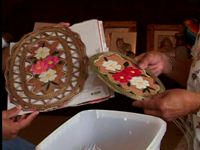 According to ancient Anishnabe legend, the Great Spirit wished for an Island retreat, so he created Manitou Minissing, or Island of the Spirits. Today it's known as known as Manitoulin Island. This is a sacred place where by tradition, the greatest leaders and warriors, medicine men and women, were buried.
According to ancient Anishnabe legend, the Great Spirit wished for an Island retreat, so he created Manitou Minissing, or Island of the Spirits. Today it's known as known as Manitoulin Island. This is a sacred place where by tradition, the greatest leaders and warriors, medicine men and women, were buried.
Located on the North East end of Lake Huron in Georgian Bay, Manitoulin Island is home to seven communities of Anishnabe, known as People of the Three Fires: The Odawa, Pottowatomi and the Ojibwe nations. For centuries before colonization, they migrated to Manitoulin's shores to receive dreams and visions. The Island's natural beauty was and is a constant source of inspiration for their art and stories.
West Bay or M'chigeeng is home to the Ojibway Cultural Foundation. It exists to preserve and revitalize Native arts and culture. The Foundation caters to the needs of 15 member communities.
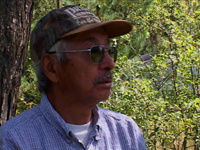 Background
Background
Under the Bond Head Treaty of 1836 Manitoulin Island became a refuge for natives wanting to live free and away from the influence of white civilization. It was known as the Manitoulin Island Indian Reserve. In 1862 the MacDougall Treaty allowed the government to divide the Island in order for non-natives to settle there, resulting in the split of Manitoulin Island into several reserves resulting the loss of language, and culture for the natives who lived there.
Alan Corbiere lives in West Bay, on Manitoulin Island, one of the reserves formed by the MacDougall Treaty, it is home to about 800 natives, Alan Corbiere has written many articles concerning the importance of language and the effects if the language is not spoken as often as it should be.
Through story telling and writing articles in the Anishinabek News, a journal based on Manitoulin Island, and with the help of his father, and that of the elders, Alan has begun to understand and speak his language better. Alan feels that this is the only way people will master their language
Mnjikaning (Rama), Ontario established in 1838-39 is located between Lake Simcoe and Lake Couchiching. In 1993, community members wanted to honor their ancestors by declaring a return of its original name, Mnjikaning. Last year Mnjikaning hosted the Anishnaabeg Language Conference. United as a group from across the country, they discussed ways to revitalize and keep their language and culture from extinction.
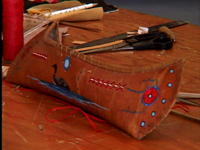 Part 1
Part 1
Words of the elders are important in maintaining true language and culture. Alan Corbiere, a young educated freelance writer feels strongly about using the Ojibway language in all factors of daily life, but especially through stories from the elders. As a freelance writer for the Anishinabek News he often writes stories told by elders which he translates to English in order for non speakers to learn about their past and culture better. Some of his articles deal with the language problems, and through his writings he hopes to educate people on the importance of nourishing their language and culture.
Alan is not a fluent speaker, yet he takes the initiative of re-telling stories from the elders as a way to teach the language. As he tells these stories, Alan's father is close by waiting to translate and help if Alan has a problem with words or sentences. During this time his dad, who is a fluent speaker will help by explaining the meaning and root of each word. There are two types of 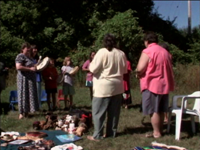 storytelling; legends and debagamoojig. Legends tells the stories of creation and myth, usually told during the winter months. Debagamoojig, are stories told during the summer months which are focused on recent times where dates and time periods can be recalled. (i.e. 1700's).. Elders have many important things to tell and teach, By recording and translating them Alan is learning everyday and by sharing these stories with other members of the community they too are learning.
storytelling; legends and debagamoojig. Legends tells the stories of creation and myth, usually told during the winter months. Debagamoojig, are stories told during the summer months which are focused on recent times where dates and time periods can be recalled. (i.e. 1700's).. Elders have many important things to tell and teach, By recording and translating them Alan is learning everyday and by sharing these stories with other members of the community they too are learning.
We visit Alan at the Ojibway Cultural Foundation in West Bay where he works as the Exhibition Coordinator.
Cultural involvement is also important to Alan as well as to other members of the community. At the Pow Wow we see how artists show their intake of language through the arts. Delia Bebonang of West Bay teaches her knowledge of culture through quillwork, we see how she uses language as a learning tool.
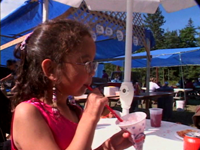 Part 2
Part 2
Nookmis Mishoomis, meaning Grandmothers and Grandfathers is a project derived from the Mother Goose Program. Here is a group that offers families the opportunity to teach their children the importance of story telling, which is an important part of the Ojibway culture. Sandy, who is founder of Nookmis Mishoomis teaches mothers and other members of families the importance of talking, touching, holding and singing to children, in the Ojibway language.
The difference in the teaching method from the school system is that it starts at home with the family. Sandy takes her group to homes to teach mothers and other members of the family how to read, sing and tell stories in Ojibway. Some members of the family do not speak the language so this is also a learning experience for the whole family.
This is a first year for the Grandmothers and Grandfathers. We visit the group as they perform their first story telling to the Native Women's Centre in Orillia, Ontario. We show how language can be taught through the telling of stories, and singing and the unity of learning ones language.
Cultural activities play a significant role in the daily lives of Ojibway, families,They enjoy gathering for singing, drumming, story telling, which are all beneficial for maintaining their culture. We film as families meet by the lake to share their stories and songs.
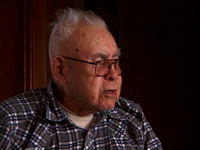 Language Keeper
Language Keeper
To help make connections between the natural environment and the Ojibway language, Alan Corbiere relies on Manitoulin's human resources. He and his father pay a visit to Sam Osawamick, an elder who has made a major contribution to the preservation of Ojibway philosophy, history and legend.

